Indian Navy Eyes Jet-Powered UAVs for Advanced Surveillance Over Indian Ocean

The Indian Navy is embarking on an ambitious plan to develop long-range, jet-powered unmanned aerial vehicles (UAVs) to enhance its surveillance and reconnaissance capabilities across the expansive Indian Ocean Region (IOR). This move is part of a larger strategy to reinforce maritime domain awareness and strengthen India’s readiness to address emerging security challenges in the region.
Why Jet-Powered UAVs?
While the Navy is already in the process of acquiring MQ-9 Reaper drones for intelligence, surveillance, and reconnaissance (ISR) missions, these UAVs are powered by turboprop engines. Despite their exceptional ability to provide persistent monitoring, turboprop UAVs lack the speed required to quickly reach distant areas of interest within the IOR, especially during emergencies or evolving situations.
Jet-powered UAVs, on the other hand, offer a significant edge in terms of operational speed and range. Equipped with jet or turbofan engines, these platforms can be rapidly deployed over vast distances, addressing the Navy's need for quicker reaction times and enhanced operational flexibility.
Key Specifications and Capabilities
The Indian Navy's requirements for these advanced UAVs include:
-
Extended Range
The UAVs must be capable of covering the vast expanses of the IOR, ensuring comprehensive surveillance of maritime activities. Proposed operational ranges could span several thousand kilometers, enabling coverage of far-flung strategic areas. -
High Speed
Jet-powered propulsion will allow these UAVs to achieve speeds upwards of 900 km/h, significantly reducing the time needed to respond to threats or incidents across the region. -
Advanced ISR Systems
These UAVs will feature cutting-edge sensors such as electro-optical/infrared (EO/IR) systems, synthetic aperture radars (SAR), and maritime patrol radars. They will also include secure satellite communication (SATCOM) systems for real-time data transmission to naval command centers. -
Endurance and Altitude
With a High-Altitude Long-Endurance (HALE) classification, these UAVs are expected to operate at altitudes exceeding 50,000 feet and remain airborne for up to 24 hours or more. -
Payload Capacity
The UAVs will be designed to carry multiple payloads, including electronic warfare (EW) systems and even small precision-strike munitions if required, making them versatile for a range of missions.
Development Roadmap
The Indian Navy plans to partner with both public and private sector defence companies within India to conceptualize and develop these advanced UAVs. Organizations like Hindustan Aeronautics Limited (HAL), Bharat Electronics Limited (BEL), and private firms such as Tata Advanced Systems and Adani Defence are expected to play a pivotal role.
To fast-track development, the Navy is also exploring international collaborations to gain access to proven technologies and expertise. Partnerships with countries like the United States, Israel, or European nations could help integrate cutting-edge avionics, propulsion systems, and ISR technologies into the indigenous platforms.
Strategic Significance
The Indian Ocean Region has become a hotspot for geostrategic competition, with the increasing presence of foreign naval forces, including those from China. The ability to maintain real-time situational awareness across this vital region is critical for India’s maritime security and broader power projection objectives.
The introduction of long-range, jet-powered UAVs will serve as a force multiplier for the Navy, enhancing its ability to monitor potential threats, secure vital sea lanes of communication, and safeguard its economic and strategic interests.
Looking Ahead
By pursuing this advanced UAV program, the Indian Navy is not only addressing immediate operational needs but also fostering domestic defence innovation. The initiative aligns with the government's push for self-reliance in defence production under the “Make in India” campaign.
Once operational, these UAVs will significantly elevate India’s maritime surveillance capabilities, reinforcing its role as a net security provider in the region and a formidable force in the Indian Ocean.



